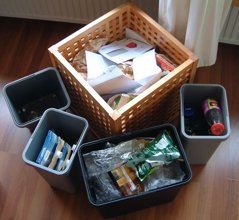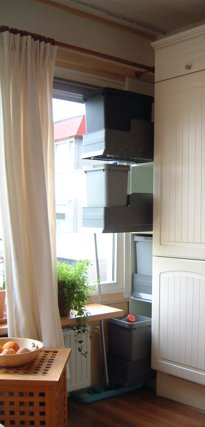Proper recycling for common households
Groen:
 Gemak:
Gemak:

The thoughts that spring to mind with recycling are overloaded boxes with flies and a funny smell. This may happen if you don't put much thought into recycling your waste, but with a bit of care and planning it is fairly easy to setup a recycling system that only has benefits.
Keywords: waste habitat health
What?
It is good to recycle, so we get to reuse materials. In places where unsorted waste is charged per weight, it can also save a lot of many. As in many situations in life, it is possible to do this in a clumsy way and build up a great dislike against recycling; but if you invest some thought in it, you should be able to setup a system that matches your home and that will bring you more benefits than downsides.

In the sequel, I will give an example from my own household, where I am very mindful about waste, but hardly ever getting it smelly. Also important, I hardly spend time carrying around waste.
There are a few core principles that I've learnt to make waste recycling a pleasant business:
- Separate organics.. When organic waste collects in a decent concentration, it can achieve the temperatures needed for composting. This is an odour-free process, provided that the following rules are also taken into account. Minute bits of organic waste, such as in the bottoms of tin cans, can get mouldy or do other unpleasant things. This is why I rinse cans before dropping them in their assigned bucket.
- Waste needs to breathe. If you airlock your waste, you risk rotting processes. This produces a very unpleasant smell. For this reason, you should keep the lids off of your waste containers, rather than shutting them tight! The only exception to this rule is the EM-process, a sort of sauerkraut-making process for waste, but that would be a deliberate choice for which you need to add ingredients; so the general rule that waste should breathe stands. An added benefit of open containers is that you can reach it easier, without having to touch the bucket all the time; this is much more hygienic!
- Clean and dry. It is a good principle to deposit your waste (virtually) dry. This avoids rust, rot and fungi. Rot leads to a bad aroma because organics decompose without oxygen when they reside under water. I have heard people who drilled holes in the bottoms of their waste containers; I collect my organic waste in a small bucket in the sink which has holes in the bottom so any moist can drip out. And of course a composting container is open to the ground on which it stands!
- Handle things only once. Recycling should not mean that you put glass waste on a temporary shelve and then load it in some container later in. I used to have things on my sink top that I had to carry downstairs; thanks to the system I describe below I can now deposit waste into their own buckets right away. They are all located in the kitchen, where virtually all waste comes into existence.
- Recycle in-transit. My nearest glass collection container is on the way to the mailbox; I can dump plastic anytime I buy a loaf of bread; the metal dump is on the way to town. This means that I spend little or no time on recycling the various flows of waste that I generate. Furthermore, since my waste is treated hygienically, it is not a dirty process, quite unlike the old-fashioned plastic bags with miscellaneous waste.
Why?
We are all consumers, buying things in stores and dumping waste. Without recycling, unsorted waste is not reusable because its composition is too complex, and so new resources must be dug up from the Earth. This is not a process that we can continue forever, and indeed we are running into its limitations: metal prices are soaring, wars over resources are fought in Africa. Recycling waste takes away the pressure from such situations, and we are responsible for less harm done.
Aside from that social issue there also are personal advantages to be gained from recycling. Anyone with a smelly waste bucket should sniff mine, which is virtually free of smell. Note however that it takes me half a year to fill one up!
In places where you pay for unsorted waste by unit of weight (or size), there clearly is money to be saved. Only sending out a bucket of garbage twice a year is not even extreme, and can easily be achieved by any individual. I may look at packaging when I buy something, but it generally does not influence my buying habits very much because there rarely is a choice in this area.
How?

I insert a few pictures of my system, which looks quite nice while it does let me recycle to my heart's desire. It is important that all these buckets are easily reachable, because then it takes no effort to dump a bit of this or a piece of that. The extending drawers with separate buckets are great because the buckets can easily be taken out to the place where the contained material is collected. In that sense, the paper box is more clumsy, because I have to repack paper into a box. Not much of an effort, but not as easy as the buckets.

There hardly is any unsorted waste left. The main contributor of this waste stream are composite materials, such as tetra packages and chips bags. I sincerely hope that competing alternatives will be created and assume that the increasing pressure on resources will actually make this a necessity. The yoghurt that I eat is a good examlple; it comes in a plastic cone with printed carton around it, and a top of metal foil. This is easily taken apart, and gives a great example of what is possible!
Where?
- The buckets and drawers come from IKEA's RATIONELL series.

![[3 uit 5 groen]](/images/green3.png)
![[4 uit 5 gemak]](/images/ease4.png)